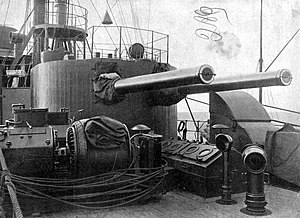| 152mm 45 caliber Pattern 1892 | |
|---|---|
 Twin gun turret aboard the cruiser Oleg | |
| Type | Naval gun Coastal artillery Railway artillery |
| Place of origin | France |
| Service history | |
| In service | 1897–2003 |
| Used by | Russian Empire Soviet Union Finland Japan Romania Estonia |
| Wars | Boxer Rebellion Russo-Japanese War World War I Russian Civil War Winter War World War II |
| Production history | |
| Designer | Canet |
| Designed | 1891 |
| Manufacturer | Obukhov Perm |
| Produced | 1897 |
| No. built | 351 |
| Variants | 1897–1901 1909–1918 |
| Specifications | |
| Mass | 5.8–6.3 t (6.4–6.9 short tons) |
| Length | 6.8 m (22 ft 4 in) |
| Barrel length | 5.3 m (17 ft 5 in) |
| Shell | Early guns: Fixed QF ammunition. Later guns: Separate QF ammunition. |
| Shell weight | 41.4 kg (91 lb) |
| Caliber | 152 mm (6.0 in) 45 caliber |
| Elevation | -6° to +25° |
| Rate of fire | 2–7 rpm |
| Muzzle velocity | 792 m/s (2,600 ft/s)[1] |
| Maximum firing range | 15.5 km (9.6 mi) at +25°[2] |
The 152mm 45 caliber Pattern 1892 was a Russian naval gun developed in the years before the Russo-Japanese War that armed a variety of warships of the Imperial Russian Navy during the Russo-Japanese War and World War I. Guns salvaged from scrapped ships found a second life on river gunboats of the Soviet Navy during the Russian Civil War and as coastal artillery and railway artillery during World War II.[2] In 1941 it was estimated that there were 196 guns (82 in the Baltic, 70 in the Pacific, 37 in the Black sea and 7 in the Northern fleet) still in use as coastal artillery. After independence in 1917 Finland was estimated to have inherited 100 guns and some remained in use until the 1980s.[2] The last was decommissioned in 2003.